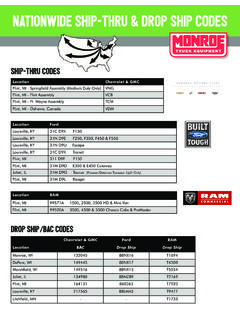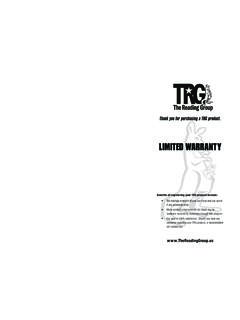Transcription of MTE Tru-Ride Air Suspension Owner’s Manual GM 4500/5500
1 MONROE TRUCK EQUIPMENT1051 W. 7th Street Monroe, WI 53566800-356-8134 Tru-Ride Air SuspensionOwner s ManualGM 4500/5500 Operation Maintenance Troubleshooting Service PartsMTE Air Suspension owner s Manual Revision Level July 28, 2008 Copyright 2007 Monroe Truck Equipment, Inc. 1051 W. 7th Street Monroe, WI 53566 No part of this Manual may be used, reproduced, or reprinted without the express written permis-sion of Monroe Truck Equipment, Inc. Notice Specifications, parts descriptions, illustrations, and instructions in this Manual were accurate at the time of publica-tion. Monroe Truck Equipment, Inc. reserves the right to discontinue products and to change specifications and designs at any time without notice and without incurring obligation. Monroe Truck Equipment, Inc. is not responsible or liable for injury, damage, or loss caused by improper installa-tion by the end user, misuse of the equipment, lack of maintenance, accidents, or failure to follow instructions.
2 In cases where equipment application was determined by the end user, Monroe Truck Equipment, Inc. is not responsi-ble or liable for injury, damage, or loss caused by misapplication of this equipment NHTSA Notification If you believe that your vehicle has a defect which could cause a crash or could cause injury or death, you should immediately inform the National Highway Traffic Safety Administration (NHSTA) in addition to notifying Monroe Truck Equipment. If NHTSA receives similar complaints, it may open an investigation, and if it finds a safety defect exists in a group of vehicles, it may order a recall and remedy campaign. However, NHTSA cannot become involved in individual problems between you, your dealer, or Monroe Truck Equipment. To contact NHTSA, you may either call the Auto Safety Hotline toll-free 1-800-424-9393 (or 366-0123) in Washington, DC area) or write to: NHTSA, Department of Transportation, Washington, DC 20590. You can also obtain other information about motor vehicle safety from the Hotline.
3 1 Table of ContentsSafety Warnings and Statements .. 2 Product Description & Specifications .. 3 Normal Operation.. 4 Emergency Operation.. 5 Routine Maintenance & Repairs .. 6-7 Troubleshooting .. 8-9 Electrical Schematic .. 10 Air Schematic.. 11 Service Parts4X2, 11K & Axle.. 13-204X4, Axle.. 21-27 Optional Equipment.. 29-35 Warranty.. 36-372 Warnings & Safety Statements NOTE The air Suspension system is not consid-ered to be user-serviceable. It is recommended that service and re-pairs be performed by a Monroe Truck Equipment facility or other truck equip-ment repair shop. WARNING Danger of electrical shock. High current potential at compressor power connec-tion. Disconnect the vehicle battery or remove the primary power fuse before removing the compressor enclosure cover. WARNING Danger of injury from release of com-pressed air. The compressed air system normally op-erates at 120 psig. Sudden release of air pressure can cause eye injuries and loss of sight.
4 Wear eye protection when working on the air system components. Disconnect power from the compressor and release all air pressure before working on the air system. CAUTION Possible wiring damage or vehicle fire from improper fusing. Do not bypass the supplied fuses in the electrical circuits. Do not install fuses with a higher current rating than those supplied. If a fuse burns out, investigate and repair the cause. 3 Product Description & Specifications Product Description The MTE air Suspension system replaces the OEM leaf spring Suspension with swing arms and air springs (inflatable air bags). An air-spring system provides a smoother ride and is self-leveling during all driving and normal loading conditions. Adjustable-dampening shock absorbers are standard with all Suspension kits. A rear sway bar is standard. The air Suspension system requires an MTE air compressor unit and air reservoir. Operating Parameters and Specifications x Required operating voltage (air compressor): +11 to 15 VDC x Operating air pressure (compressor shut-off) setpoint: 120 psig, + 5 psig x Operating temperature range: -40 to 130o F CAUTION The air Suspension system is a load-leveling system designed to maintain a specified ride height.
5 The specified ride height sets the inflat-able air bags at their mid-point of travel when the Suspension is at rest. Operation of the vehicle with the ride height set too high or too low may per-manently damage the air bags. ride Height (Measurement H shown at right) 4 x 2 wheel drive 4 x 4 wheel drive So-Low 4 x 2 wheel drive H Softest Setting R Standard MTE Setting F High Center of Gravity Vehicles (Ambulances & Buses) XF Shock Absorber Settings To adjust settings, follow directions on the shocks. 4 Normal Operation Normal Operation of the Air System y For normal operation, keep the Dump (Kneel) switch off. y Start the vehicle engine. If the air pressure in the system is low, the compressor will start immediately. When the pressure reaches the normal operating pressure, the compressor will stop automatically. y Normal maximum operating pressure is 120 psig. The compressor will start whenever the pressure drops to about 100 psig. y Whenever the vehicle is running, you will hear the compressor start and stop occasionally.
6 The frequency of com-pressor cycling depends on the amount of movement at the rear Suspension . As the Suspension moves, it consumes and releases air pressure to keep the chassis level. The more the Suspension moves up and down, the more fre-quently the compressor will have to run. y To lower the rear of the vehicle when connecting a trailer, activate the Dump (Kneel) switch. The Suspension will immediately deflate. When the trailer is connected, shut off the Dump switch and verify that the Suspension returns to the normal ride height. Never drive the vehicle with the Suspension in the Kneel position. y It is normal for the compressor to start when the Dump function is shut off and the Suspension begins to inflate. Dump/Kneel Switch 5 Emergency Operation System Operation During Compressor Failure If the compressor or other component in the enclosure fails and the compressor will not run, air pressure can still be maintained in the Suspension system until repairs can be made.
7 Use a compressed air source and a standard tire valve chuck to add air at the Schrader valve in the end of the air tank. y Do not exceed 120 psig when adding air to the tank manually. y If the vehicle must be operated for an extended period in the failure mode, air will have to be added occasionally to compensate for losses due to movement of the Suspension . y If there is an air leak in the system, Manual filling of the tank may not be effective except for moving the vehicle a short distance. y Do not use the Dump (Kneel) function if the system is operating in the failure mode. CAUTION Never drive the vehicle with the air bags deflated. Permanent damage to the air bags may occur. If the compressor system fails, add air manually to the air tank to allow the vehi-cle to be moved to a repair location. Repair the cause of the compressor sys-tem failure as soon as possible. Manual air fill valve 6 Routine Maintenance Notes 1. Pull cable attached to drain valve at bottom of tank.
8 2. If the air tank is equipped with the optional automatic drain valve, the valve should open briefly each time the com-pressor runs. Task Frequency Weekly Monthly Annually Other Blow down moisture in air tank 1, 2 X Activate Dump (Kneel) function X Observe/check ride height X Inspect wiring harnesses & air tubing X Inspect shock absorbers X Replace at 50,000 miles. Inspect Suspension components and bushings X Initial inspection after first 1,000 miles. Inspect condition of air bags X Tighten Suspension component fasteners X Initial check after first 1,000 miles. Tighten every 25,000 CAUTION The vehicle owner is responsible for inspection after first 1,000 miles of operation, periodic inspections, maintenance, and proper use of the system. Suspension components must be inspected and all fasteners and U-bolts retightened after the first 1,000 miles of operation. Failure to retighten all Suspension fasteners at 1,000 miles may result in damage to Suspension compo-nents or the axle.
9 NOTE Refer to the Air Compressor owner s Manual for maintenance information on the air system. 7 Spring Hanger to Frame: 80 ft-lbs Air Spring Bracket to Frame: 80 ft-lbs Lateral Control Rod Bracket to Frame: 80 ft-lbs Lateral Control Rod Bracket to Axle (U-Bolts) 150 ft-lbs Lateral Control Rod Flange Nuts 140 ft-lbs Air Spring mount to Spring Arm 30 ft-lbs Spring Arm Axle Mount (U-Bolts) 275 ft-lbs Spring Arm Front Mount Pivot 240 ft-lbs Shock Absorber Nuts 60 ft-lbs FASTENER TORQUE VALUES Routine Maintenance Repairs y Major repairs and Suspension component replacement should be performed by a qualified service technician. 8 Tro u b l e s h o o t i n g S u s p e n s i o n Problem Possible Causes Air bags do not inflate bags de-flated 1. Dump (kneel) switch on. 2. Compressor unit failure. 3. Large air leak in system. 4. Leveling valve link rod(s) dis-connected. 5. Pinched or kinked air hose between air tank and leveling valve(s) One air bag deflated 1.
10 Air bag ruptured, leaking. 2. Leveling valve for bag discon-nected or defective. 3. Air hose to bag kinked or plugged. ride height low, high, or uneven from side to side 1. Leveling valve(s) not adjusted properly. 2. Leveling valve arm or link rod bent. 3. Defective leveling valve Suspension does not respond when weight is added or removed from chassis. 1. Leveling valve link rod(s) dis-connected. 2. Leveling valve defective. Excessive vertical movement of body on Suspension or wheel hop under hard braking 1. Shock absorbers not set to correct firmness. 2. Shock absorbers worn out. Solutions 1. Turn Dump function off. 2. Refer to troubleshooting instruc-tions for air compressor. 3. Check for and repair leaks. 4. Reconnect link rod(s), adjust ride height if required. 5. Inspect all air hose routings, re-1. Check for air leaks at bag, replace if ruptured. 2. Check leveling valve link rod. Re-connect and adjust. Replace valve if defective.

